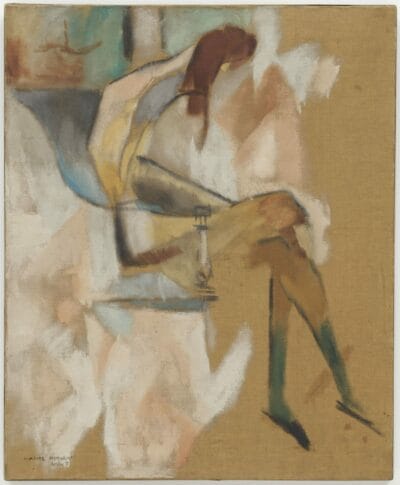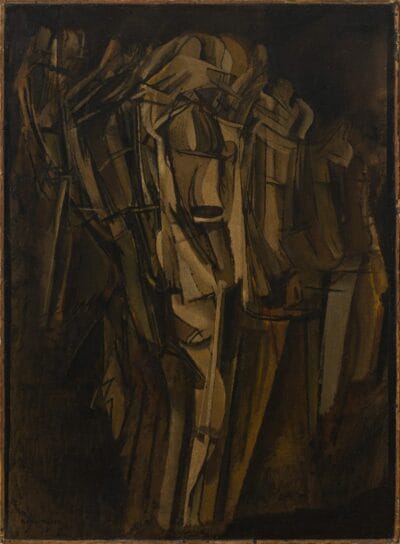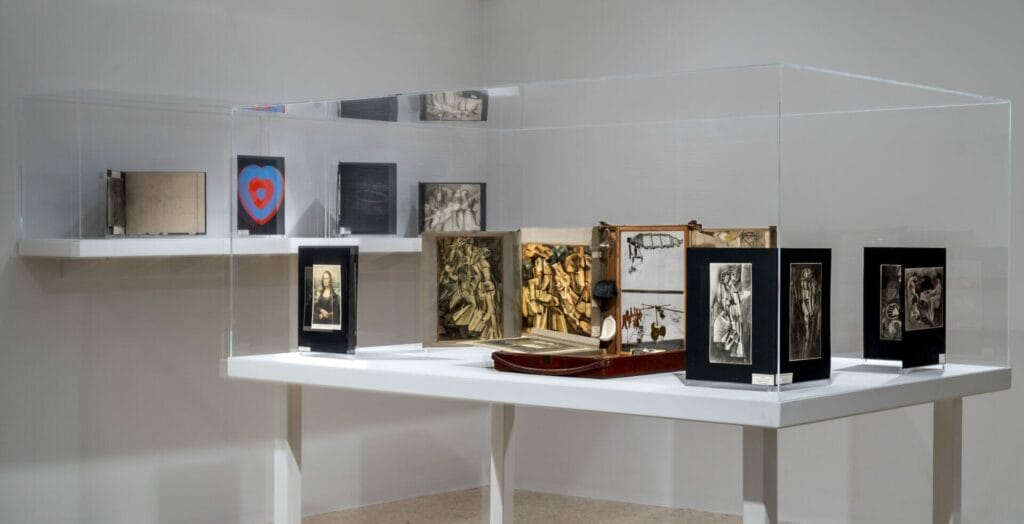From October 14, 2023, to March 18, 2024, the Peggy Guggenheim Collection presents Marcel Duchamp and the Lure of the Copy, curated by Paul B. Franklin, a Paris-based art historian and an internationally acclaimed expert on the life and work of Marcel Duchamp (1887–1968). This is the very first exhibition at the Peggy Guggenheim Collection devoted exclusively to Duchamp, among the most influential and innovative artists of the twentieth century and a longtime friend and adviser to the U.S. patron Peggy Guggenheim.

Marcel Duchamp and the Lure of the Copy features some sixty artworks dating from 1911 to 1968. These include iconic objects from the permanent collection of the Peggy Guggenheim Collection, such as Nu (esquisse), jeune homme triste dans un train (Nude [Sketch], Sad Young Man in a Train) (1911–12) and de ou par Marcel Duchamp ou Rrose Sélavy (Boîte-en-valise) (from or by Marcel Duchamp or Rrose Sélavy [Box in a Valise]) (1935–41), as well as from other Italian and U.S. institutions, including the Galleria Nazionale d’Arte Moderna e Contemporanea in Rome, the Philadelphia Museum of Art, the Museum of Modern Art in New York, and the Solomon R. Guggenheim Museum in New York. The exhibition also presents several lesser-known artworks in private hands, including the artist’s estate. Furthermore, fully half of the works on display come from the distinguished Venetian collection of Attilio Codognato, who first took an interest in Duchamp’s work in the early 1970s. This is the first time that such a broad selection of Duchamp’s works in the Codognato collection is displayed in an exhibition.
Peggy Guggenheim met Marcel Duchamp in Paris around 1923. Beginning in the fall of 1937, the artist was one of her most trusted mentors and advisors, as she set out to launch the art gallery Guggenheim Jeune, which opened in London on January 24, 1938, and soon after to build her own collection of modern art. In her memoirs, Confessions of an Art Addict (1960), Guggenheim recalled: “I needed much help and advice, which I got from an old friend, Marcel Duchamp . . . I don’t know what I would have done without him . . . I have to thank him for my introduction to the modern art world.” Guggenheim was also one of Duchamp’s early patrons, acquiring the first copy of the deluxe edition of Box in a Valise in 1941.
Despite having executed some of the most recognizable canvases of the twentieth century, such as Nude (Sketch), Sad Young Man in a Train and Le Roi et la reine entourés de nus vites (The King and Queen Surrounded by Swift Nudes) (1912), a masterpiece from the Philadelphia Museum of Art which will be on view in the exhibition, Duchamp abandoned easel painting in 1918 at the age of thirty-one. For the next
fifty years, he engaged in multiple creative acts, virtually none of which was considered high art at the time. In addition to those endeavors, he repeatedly reproduced his own work in different media and on various scales. These meticulously executed copies enabled him to disseminate his otherwise modest output without generating anything indisputably new. As a result, he also deftly circumvented the voracious art market. In reproducing his work in different media, on various scales, and in limited editions, Duchamp illustrated that certain duplicates and the originals from which they were replicated offered comparable forms of aesthetic pleasure. In so doing, Duchamp also redefined what constitutes a work of art and, by extension, the identity of the artist. Throughout his oeuvre, he continually called into question the traditional hierarchy between original and copy. “As for distinguishing the real from the fake, the imitation from the copy, those are totally idiotic technical questions,” he announced in 1967 in an interview. On another occasion, he argued: “A duplicate or a mechanical repetition has the same value as the original.” For Duchamp, the ideas embodied in a work of art were of equal significance as the physical object itself. The importance that he accorded to aesthetic concepts inspired him to reproduce his own work repeatedly and with meticulous exactitude, beginning with the Boîte de 1914 (Box of 1914, 1913–14/15), a series of photographic facsimiles of handwritten notes, and continuing into the 1960s, with replicas of his historic readymades.

Examining the radically innovative and varied ways that Duchamp quoted himself over the course of his long career as an artist, Marcel Duchamp and the Lure of the Copy is organized in several interrelated sections—Origins, Originals, and Family Resemblances; Past Is Prologue; The Magic of Facsimiles; Authentic Copies; Disciplining and Emboldening the Hand; Cloning the Self, Clothing the Other; Hypnotic Repetition; and Themes and Variations. The exhibition centers on Box in a Valise, an innovative compilation of reproductions and miniature replicas of his creations, and no. I of the deluxe edition of twenty travelling suitcases—the earliest of which is marked Louis Vuitton—featuring an inscription dedicated to Peggy Guggenheim: “Pour Peggy Guggenheim ce No 1 de vingt boîtes-en-valise contenant chacune 69 items et unoriginal et par Marcel Duchamp Paris Janvier 1941.” “Everything important I have done,” Duchamp professed, “can be put into a small suitcase.” Box in a Valise is Duchamp’s most compelling encapsulation of his passion for replication as a unique mode of creative expression. Such an overview enables the viewer to grasp the astonishing scope of Duchamp’s lifelong preoccupation with replication as a distinct medium of artistic expression. It also illustrates the extent to which his whimsical, often-hybrid handiworks perturbed and at times totally eluded standard artistic classifications in use at the time of their conception.
A section of the exhibition focuses on Duchamp and Guggenheim’s close and enduring relationship: photographs, archival documents, and publications attest to the long friendship between them, two very different but equally colorful personalities. They also reveal the privileged place that Duchamp’s work occupied in the exceptional art collection that Guggenheim amassed with his guidance.
Marcel Duchamp and the Lure of the Copy thus offers a rare opportunity to examine a significant selection of the artist’s works in relation to one another, an exercise, as Duchamp frequently argued, essential to comprehending his aesthetic project. In so doing, not only can one discern the intricate visual, thematic, and conceptual connections that unify them as an oeuvre, but also one can grasp the extent to which these whimsical, often-hybrid “items” troubled and sometimes totally escaped standard artistic classifications in use at the time of their conception. The exhibition is accompanied by a richly illustrated catalogue, published by Marsilio Arte, which contains a substantial essay by curator Franklin.
The last section of the show, titled Marcel Duchamp: Exploring the “Box in a Valise”, is a scientific exhibition organized by the Conservation Department of the Peggy Guggenheim Collection and the Opificio delle Pietre Dure in Florence. This presents the results of a scientific study carried out in two stages, in 2019 and 2023, in the conservation and restoration laboratories of the Opificio delle Pietre Dure, with the support of EFG Banking, an Institutional Patron of the Peggy Guggenheim Collection since 2006. A multimedia installation offers a fascinating and unique exploration of the world of conservation. Visitors can delve into the techniques and materials employed by the artist to create an icon of twentieth-century art, as well as the scientific investigation and analysis techniques used by conservators to better understand it, and the solutions they employed to ensure its best conservation. A video and a touchscreen offer visitors a chance to explore the Box in a Valise, both as a single unit, as the artist intended, as well as through each of the 69 elements contained inside it and the complex structure that displays them.


[tribe_event_inline id=”1128874″]
{title}
{thumbnail}
Start Date: {start_date}
End Date: {end_date}
Venue: {venue:name}
Address: {venue_address}
Description: {excerpt}
[/tribe_event_inline]
